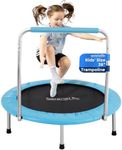Buying Guide for the Best Fitness Trampolines
Choosing the right fitness trampoline can significantly enhance your workout routine, providing a fun and effective way to improve your cardiovascular health, balance, and coordination. When selecting a fitness trampoline, it's important to consider several key specifications to ensure you get the best fit for your needs. Understanding these specifications will help you make an informed decision and get the most out of your purchase.SizeThe size of a fitness trampoline is crucial as it determines the amount of space you have for your workout. Trampolines typically range from 36 inches to 55 inches in diameter. Smaller trampolines (36-40 inches) are more compact and suitable for limited spaces, making them ideal for indoor use. Medium-sized trampolines (40-48 inches) offer a balance between space and usability, while larger trampolines (48-55 inches) provide more room for movement and are better for more vigorous workouts. Choose a size that fits your available space and workout intensity.
Weight CapacityWeight capacity indicates the maximum weight the trampoline can safely support. This is important for ensuring safety and durability. Trampolines generally support weights ranging from 200 to 400 pounds. If you are on the heavier side or plan to use the trampoline for high-intensity workouts, opt for a higher weight capacity to ensure stability and longevity. Always check the manufacturer's specifications to match your weight with the trampoline's capacity.
Spring TypeFitness trampolines use either metal springs or bungee cords to provide bounce. Metal springs offer a firmer, more responsive bounce, which can be beneficial for high-intensity workouts. Bungee cords, on the other hand, provide a softer, quieter bounce, which is gentler on the joints and ideal for low-impact exercises. Consider your workout style and any joint issues when choosing between spring types. If you prefer a quieter, joint-friendly option, go for bungee cords; if you need a more robust bounce, metal springs might be better.
Frame MaterialThe frame material affects the trampoline's durability and stability. Most fitness trampolines are made from steel or aluminum. Steel frames are strong and durable, making them suitable for intense workouts and heavier users. Aluminum frames are lighter and more portable, which is great for those who need to move the trampoline frequently. Consider how you plan to use the trampoline and whether portability or durability is more important for your needs.
Mat MaterialThe mat material impacts the comfort and longevity of the trampoline. High-quality mats are typically made from polypropylene or Permatron, which are durable, UV-resistant, and provide a good bounce. Cheaper mats may wear out quickly and provide less support. If you plan to use the trampoline frequently, investing in a high-quality mat will ensure better performance and a longer lifespan. Look for materials that are known for their durability and comfort.
Stability FeaturesStability features such as non-slip feet, adjustable legs, and handrails can enhance the safety and usability of a fitness trampoline. Non-slip feet prevent the trampoline from moving during use, adjustable legs allow you to customize the height, and handrails provide extra support for balance. If you are new to trampoline workouts or have balance issues, look for models with these stability features to ensure a safer and more comfortable experience.
FoldabilityFoldability is an important feature if you have limited storage space or need to transport the trampoline. Some fitness trampolines can be folded in half or quarters, making them easy to store under a bed or in a closet. If space is a concern or you plan to take your trampoline to different locations, choose a model that offers easy foldability and comes with a carrying case for convenience.

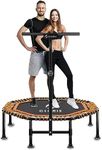
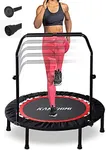

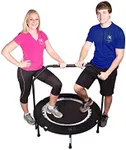




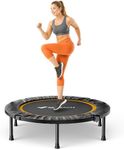

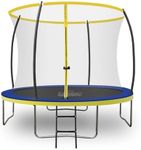
![Darchen 200 KG Mini Trampoline for Adults, Indoor Small Rebounder Exercise Trampoline for Workout Fitness for Quiet and Safely Cushioned Bounce, [100 CM]](https://images-proxy.bestreviews.guide/-vafXykk80TrpxOjwGjjl-JaSiQ=/0x150/https://m.media-amazon.com/images/I/41hgnBQOBvL._AC_CX679_.jpg)


